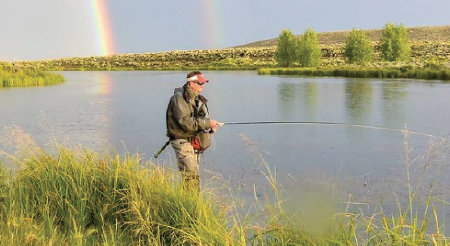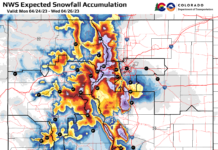
by Marissa Lorenz
Just one week after Colorado Parks & Wildlife (CPW) asked “anglers to voluntarily avoid fishing on the Colorado River between Kremmling and Rifle” due to “extremely low flows and warm water temperatures,” water levels have come up and temperatures have receded, permitting an end to the voluntary fishery closure and providing some much-desired relief for fishers and boaters on the highly-recreated area known as the Upper Colorado.
The area has been under great stress for most of the 2021 summer season as the combination of a below-average snowpack, reduced spring runoff, and exceptional drought conditions (the most intense classification on the US Drought Monitor) has meant water flows between 300 and 600 cubic feet per second (cfs) for most of the last two months, a time period during which median flows over the last 58 years have been closer to 1700 to 1800 cfs.
But water flow finally rose to over 700 cfs on Friday and has been over 1000 cfs for the last two days.
Water temperatures during the same period have routinely reached 65 degrees and above, spiking near 75 degrees in mid-June–temperatures at which oxygen in the river drops to dangerous lows, according to local expert and guide Bob Dye, who published a book on fly fishing on the Upper Colorado and its tributaries in 2018.
“It was killing the fish,” says Dye of the water temperatures that have come down in the last week, remaining below the alarming 65-degree mark since Sunday.
Grand County Manager Ed Moyer helped to provide explanation for the long-awaited turnaround at Tuesday’s regular meeting of the Board of County Commissioners (BOCC) when he indicated that the Cameo Call went into effect on Sunday, triggering additional water releases out of the Green Mountain and Williams Fork reservoirs.
The Cameo Call consists of a series of senior water rights dating from 1912 through 1934 that serve mostly to provide irrigation and power in the Grand Valley near Grand Junction. The Call overrides all upstream junior rights holders and means that waters that would otherwise be dammed or diverted from much nearer their source are allowed to remain instream until reaching the Grand Valley.
According to a 2004 white-paper by the Roaring Fork Conservancy, “The Call’s length depends on how dry the season is and how much water is diverted by junior users upstream. In drier years, the Division of Water Resources administers the Call for a longer period of time as it comes on earlier in the season. Regardless of dryness, though, the Call comes on every year simply because the river is over-appropriated.”
A May 2021 update by the Colorado Division of Water Resources indicated that the Cameo Call had also been utilized for a 17-day period in April of this year, an “unusual and substantially longer [time period] than past April Cameo Calls.”
Moyer indicated that, given the call, Green Mountain Reservoir had released 511 cfs on Tuesday, helping to bring water flows up to a “probable peak” for the summer.
Dye indicates that the Call is especially good for the fishery. “We really needed that water from Green Mountain,” he says, explaining that the water being released out of the bottom of Green Mountain Reservoir provides much cooler waters much closer to the strained section of water than spills from the surface of reservoirs or from those reservoirs that are much further away.
He says the faster waters help flush mud and silt that has settled in the riverbed and also provide improved whitewater for rafters.
Jeff Moritz, General Manager at the AVA Rafting & Fishing Guide-Kremmling Outpost, is just as enthusiastic about the improved river conditions. Up until now, he says, the company has been missing out on business, having to cancel afternoon fishing trips when temperatures have been too high and having fewer rafting bookings and rentals due to the low water flows.
Moritz notes that AVA, a 20-plus year old company, which also has outposts on other rivers throughout the state, tries to stay engaged in the water conversation, hoping to provide an industry voice where possible.
“It’s a battle at a very high level,” Moritz says of perpetual water rights struggles in the Colorado River Basin.
“We have worked with the BLM over the last few years to do periodic floats, showing legislators or other leaders our river, show them why we love it and why we want to keep water in it.”
But improved water conditions on the section of the Colorado near Kremmling does
not mean that all local water concerns have been relieved.
Bull Basin Guides and Outfitters, owned by Dean and Susan Billington, leases water on Troublesome Creek, a tributary of the Colorado that runs through and below the burn scar from last year’s East Troublesome Fire, which burned over 192,000 acres.
Susan observes that, in addition to having to scale back fishing because of excessive water temperatures, recent rains are washing debris down from the burn area. Her hope is that the moisture along with water being returned to the stream as the irrigation season ends will improve conditions for members and guests.
And Manager Moyer indicates that there is still a decided concern for the fishery between Williams Fork Reservoir and Windy Gap. He says that the County is working with the US Fish and Wildlife Service and other water partners, such as Denver Water and Northern
Water, in consideration of a “possible exchange” whereby some of Lake Granby’s “5412 water” could be released early.
He refers to 5,412.5 acre-feet (AF) of water stored in Granby for the express purpose of aiding endangered fish habitat further downstream, also in the Grand Valley area.
That water is typically held until the beginning of August, when it is released in the amount of 35 cfs, according to Moyer, in order to maintain a 75 cfs release out of Granby Reservoir when flows would otherwise drop to 40 cfs. It will begin release on August 1 if it does not start earlier.








